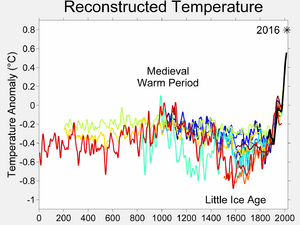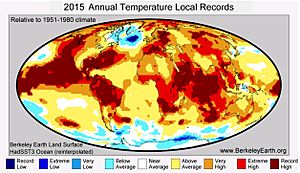Global warming facts for kids
Global warming means the average temperature of Earth's surface, oceans, and air is going up. This change happens over many years. Today, average temperatures are about 1 °C (1.8 °F) higher than before the Industrial Revolution. This period started around 1750, which was during a very cold time called the Little Ice Age. Some parts of the world have warmed more, and some less.
Many scientists think that by the year 2100, temperatures could be 1.5 °C (2.7 °F) to 5 °C (9.0 °F) higher than they were before 1750. The biggest change we see from this warming is that ice caps all over the world are melting. This causes the sea level to rise steadily. Many cities near the ocean might face floods in the 21st century. Most scientists agree that humans are the main cause of global warming.
One of the main reasons for global warming is the increase of carbon dioxide in the atmosphere. This was predicted by Svante Arrhenius over a hundred years ago, building on the work of Joseph Fourier even earlier. When people burn fossil fuels like coal, oil, and natural gas, they release a lot of carbon dioxide into the air. This happens because fossil fuels have a lot of carbon, and burning them combines this carbon with oxygen. Also, when many trees are cut down (deforestation), less carbon dioxide is taken out of the atmosphere by plants.
As the Earth's surface gets hotter, the sea level rises. This happens partly because water expands when it gets warmer. It also happens because warm temperatures make glaciers and ice caps melt. Rising sea levels can cause coastal areas to flood. Weather patterns are also changing, including where and how much rain or snow falls. Deserts might get bigger. Colder areas are warming faster than warm areas. Strong storms could become more common, and farming might produce less food. These changes will not be the same everywhere, and how they affect different areas is still being studied.
People in government and groups like the Intergovernmental Panel on Climate Change (IPCC) are talking about global warming. However, governments, companies, and other people don't always agree on what to do. Some ideas to reduce warming include burning fewer fossil fuels, planting more trees, eating less meat, and storing carbon dioxide underground. Another idea is to shade the Earth from some sunlight (called geoengineering), but we don't fully understand how this might affect weather in other ways. People could also try to adapt to the temperature changes. Agreements like the Kyoto Protocol and Paris Agreement aim to reduce pollution from burning fossil fuels. Most governments have agreed to these, but some people in government think nothing should change. Even gas produced by cows during digestion causes global warming, because it contains a greenhouse gas called methane.
Contents
How Earth's Temperature Changes

Climate change has always happened throughout Earth's history, including times when ice ages came and went. But modern climate change is different because people are adding carbon dioxide to the atmosphere very quickly.
Since the 1800s, people have recorded daily temperatures. By about 1850, there were enough places measuring temperature for scientists to figure out the global average temperature. Compared to before people started burning a lot of coal for industry, the temperature has gone up by about 1 °C (1.8 °F). In 1979, satellites began measuring Earth's temperature from space.
Before 1850, there weren't enough temperature measurements to know exactly how warm or cold it was. Climatologists use "proxy" measurements to guess past temperatures before thermometers existed. This means measuring things that change when it gets colder or warmer. For example, they can cut into a tree and measure the distance between its growth rings. Trees that live a long time can show how temperature and rain changed during their lives.
For most of the past 2000 years, the temperature didn't change much. There were some slightly warmer or cooler times. A famous warm period was the Medieval Warm Period, and a famous cool period was the Little Ice Age. Other proxy measurements, like temperatures taken in deep holes in the ground, mostly agree with tree ring data. Tree rings and boreholes can help scientists understand temperatures back to about 1000 years ago. Ice cores, which are long tubes of ice drilled from glaciers, can show temperatures from as far back as half a million years ago.
The Greenhouse Effect Explained
Coal-burning power plants, car exhausts, factory smokestacks, and other human-made sources release about 23 billion tons of carbon dioxide and other greenhouse gases into Earth's atmosphere every year. The amount of CO2 in the air is about 31% more than it was around 1750. About three-quarters of the CO2 that people have put into the air in the last 20 years comes from burning fossil fuels like coal or oil. The rest mostly comes from changes in how land is used, such as cutting down trees.
How the Sun Affects Warming
The Sun gets a little bit hotter and colder every 11 years. This is called the 11-year sunspot cycle. This change is so tiny that scientists can barely measure how it affects Earth's temperature. If the sun were causing Earth to warm up, it would warm both the surface and the air high up. But the air in the upper stratosphere is actually getting colder. So, scientists don't think changes in the sun have much effect on current global warming. Also, over hundreds of millions of years, the sun is slowly getting brighter.
Dust and Dirt in the Air
Dust and dirt in the air can come from natural sources like volcanos, erosion, and tiny bits of meteors. Some of this dirt falls out of the air within a few hours. Some of it is so small it becomes an aerosol and can stay in the air for years. These aerosol particles in the atmosphere actually make the Earth colder. So, the effect of dust cancels out some of the warming from greenhouse gases. Even though humans also put aerosols into the air when they burn coal or oil, this only cancels out the greenhouse effect for less than 20 years. The carbon dioxide stays in the atmosphere much longer and keeps warming the Earth.
History of Climate Change Science
As early as the 1820s, scientists started learning about climate change. Joseph Fourier thought that light from the sun could enter the atmosphere easily, but it couldn't leave as easily. He tried to show that air can absorb infrared radiation and send it back to Earth's surface. Later, in 1859, John Tyndall found that water vapor and CO2 trap heat waves from the sun. In 1896, Svante Arrhenius tried to prove that it would take thousands of years for the CO2 from factories to raise Earth's temperature by 5-6°C.
However, in the early 20th century, many people didn't believe this idea because it seemed too simple. In the mid-20th century, scientists discovered that carbon dioxide in the atmosphere had increased by 10% during the 19th century, making it a little warmer. At this time, people thought CO2 emissions would grow very fast in the future, and that the oceans would soak up any extra greenhouse gases. In 1956, Gilbert N. Plass argued that greenhouse gas emissions would indeed affect Earth's temperature and that ignoring them would be a mistake. Soon after, scientists from different fields began working together to understand greenhouse gas emissions and their effects. As technology improved, by the 1980s, there was clear proof of rising CO2 levels. An ice core, obtained by drilling deep into ice sheets, provided strong evidence that carbon dioxide levels had increased.
How Global Warming Affects Sea Levels
Global warming means that the ice sheets in Antarctica and Greenland are melting. Also, the oceans are expanding as they get warmer. A scientific paper in Science suggested that recent climate change would still cause a 6 meters (20 ft) sea-level rise, even if greenhouse gas emissions were reduced in 2015.
Low-lying areas like Bangladesh, Florida, the Netherlands, and other regions could face huge floods.
Cities Threatened by Rising Sea Levels
Many cities are ports and are at risk of flooding if the current sea level keeps rising.
These cities, and others, have either started trying to deal with rising sea levels and related storm surges, or they are discussing what to do:
- London
- New York City
- Norfolk, Virginia, in the Hampton Roads area of the United States
- Southampton
- Crisfield, Maryland, United States
- Charleston, South Carolina
- Miami, Florida, has been called "the number-one most vulnerable city worldwide" because of possible damage from storm floods and sea-level rise.
- Saint Petersburg
- Sydney, Australia
- Jakarta
- Thatta and Badin, in Sindh, Pakistan
- Malé, Maldives
- Mumbai, Buenos Aires, Los Angeles, Rio de Janeiro
All other cities along the coast are also in danger.
Related pages
Images for kids
-
Data has been cherry picked from short periods to falsely assert that global temperatures are not rising. Blue trendlines show short periods that mask longer-term warming trends (red trendlines). Blue dots show the so-called global warming hiatus.
-
Ecological collapse. Bleaching has damaged the Great Barrier Reef and threatens reefs worldwide.
-
Extreme weather. Drought and high temperatures worsened the 2020 bushfires in Australia.
-
Arctic warming. Permafrost thaws undermine infrastructure and release methane, a greenhouse gas.
-
Habitat destruction. Many arctic animals rely on sea ice, which has been disappearing in a warming Arctic.
-
Pest propagation. Mild winters allow more pine beetles to survive to kill large swaths of forest.
-
Environmental migration. Sparser rainfall leads to desertification that harms agriculture and can displace populations. Shown: Telly, Mali (2008).
-
Agricultural changes. Droughts, rising temperatures, and extreme weather negatively impact agriculture. Shown: Texas, US (2013).
-
Tidal flooding. Sea-level rise increases flooding in low-lying coastal regions. Shown: Venice, Italy (2004).
-
Storm intensification. Bangladesh after Cyclone Sidr (2007) is an example of catastrophic flooding from increased rainfall.
See also
 In Spanish: Cambio climático para niños
In Spanish: Cambio climático para niños




















